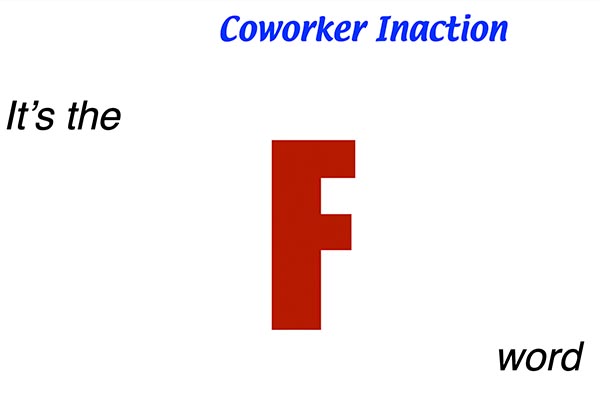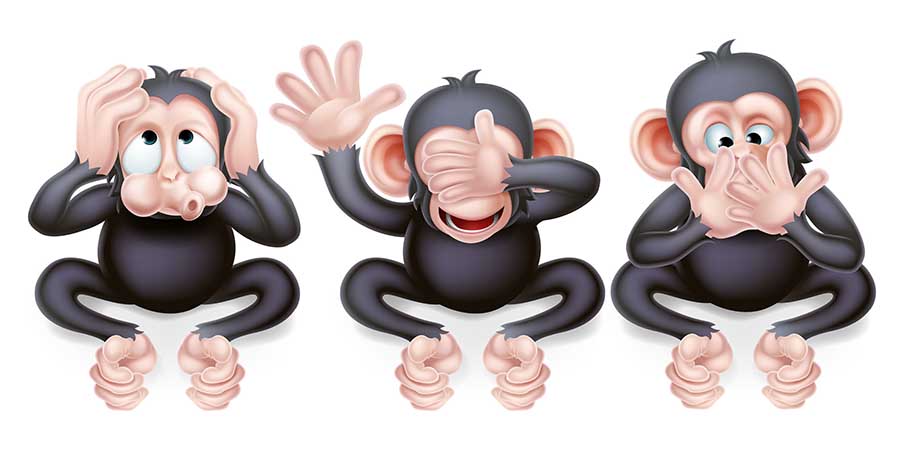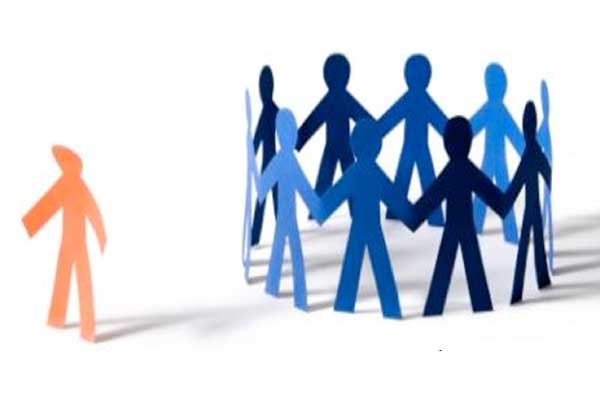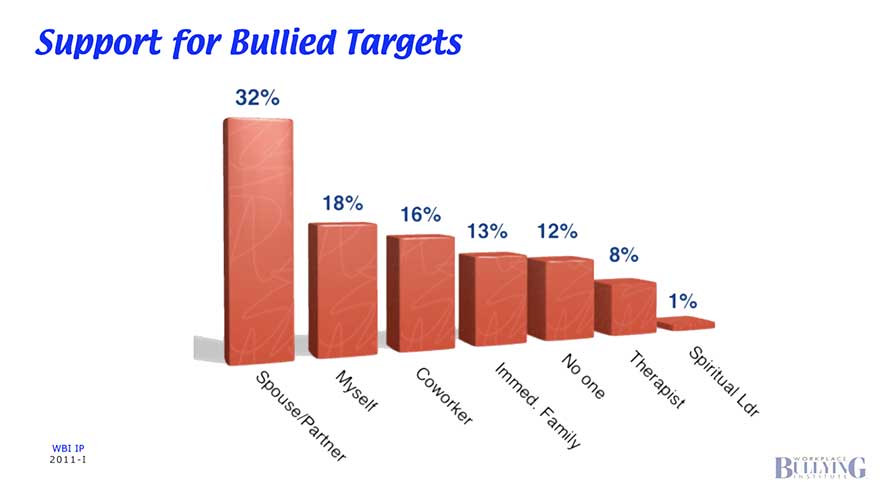About Your Perplexing Coworkers
Recall that one-third of the bullying comes from coworkers, your peers. In this section, I want to discuss your do-nothing coworkers when your bully is not one of them.
Doing Nothing
To understand their
strange behavior,
consider the F word.

Yes, it’s fear. Whether or not it is rational, coworkers fear intervening to try to stop the bullying in real time because it feels too risky, too dangerous. Not physical danger, but perceived risk of becoming the next target. They do a quick analysis and decide to not act to help you to save their own necks. Or they may fear standing out from the group by being the lone helper.
Being the first, the only takes courage most people lack. Or they fear botching either the intervention or offer to help. They might do it wrong or give poor unsolicited advice. Or they deliberately do nothing to help believing it would invade your privacy. Sometimes we live in “silos” and prefer to “stay in our lane.” This is a cold view of the world that absolves us of any responsibility to our fellow human beings. We leave others alone. Its foundation is American individualism.
Unfortunately, the societal norm violates our human nature. We are social animals. We bond in groups. The need to belong to a group is a fundamental human need that transcends societal rules. That need is what gives the group so much power over us.

When coworkers do nothing to help, they have to fake not knowing what happened to you. It’s easy to notice you emerging from the bully’s office slump-shouldered. Your body language reveals your emotions. Any reasonable person would jump up to comfort you. To avoid doing so, coworkers avert their gaze, pretending not to see. This reduces their guilt and allows them to rationalize doing nothing. Truthfully, you are so sullen and defeated, you don’t notice what others are doing. Your focus is on the shock of what happened to you. Over time, coworker neglect becomes the norm and you feel abandoned by your former friends. This deprives you of social support necessary to mitigate your distress.
“DOING NOTHING IS NOT BEING NEUTRAL!”
It condones the bully’s outrageous conduct. Coworker inaction helps sustain bullying with impunity.
From a WBI study of coworker actions (as told by bullied targets), we know they do the following: stop the bullying by confronting as a group (0.8%), offer advice (7%), give moral and social support (28%), do nothing (16%), voluntarily isolated the target (13%), isolated the target on bully’s order (5%), betrayed the target while pretending to be a friend (13%), and became the bully’s ally and was aggressive to the target (15%).
The Bystander Effect
Social psychologists described the phenomenon to explain the failure of witnesses to intervene in a woman’s murder in Queens in 1964. Urban legend has it that 38 people did nothing at the first opportunity to help. Turns out that was not true. Someone did physically chase the assailant away before he returned to finish the murder. The Kitty Genovese murder prompt the 911 call system.
The science, however, holds up. The larger the group of witnesses to wrongdoing, the probability that any one person helps drops. If you want help, have only one or two witnesses. It’s a matter of diffusion of responsibility. In large groups, everyone believes that someone else will intervene. The result is that no one does. The bystander effect can explain the non-intervention by witnesses to bullying.
The Abilene Paradox
This is my preferred explanation for the group’s apparent indifference to the plight of their bullied coworker. Jerry Harvey, a Texan, is father to the phenomenon named after the town. It states that people in a group that publicly makes a critically poor decision (not helping their bullied colleague) is actually a group that knows it is wrong to do so. You see, paradoxically, each person holds the private belief that they should act to help. The group is not in conflict. Each person betrays her or his private stance by voting publicly to do nothing. Why?
Harvey says that it is fear of separation from the group that compels each person to fail to act. No one wants to be the first to act. Then, seeing that no one took the appropriate and right action (helping the target), they incorrectly assess imagined risks of intervening that prove to be worse than the real risks to the group and target from continuing to do nothing. They engage is worst case thinking. Therapists call this catastrophizing. The world will end as we know it if we help her. This thinking justifies inaction.
A group on the “road to Abilene” is one that never breaks the silence. If they did, they would discover that most of them wanted to help the target but kept it to themselves believing the others did not want to help. Harvey differentiated the group from one in conflict and one that simply mismanaged its silent, private agreement about the right thing to do.
The Pain of
Ostracism

Ostracism or social exclusion describes the group’s decision, deliberate or not, to expel their coworker, the bullied target. Involuntary separation from the group to which the target might have belonged for over a decade comes with consequences. Neuroscience research using fMRI (see Health Impact Target Tutorial) shows that ostracism activates pain pathways in the brain, actual physical pain sensations. Pain is followed by sadness. Anger accompanies the denial of the fundamental need to belong to a group. The response to thwarting that need differs across individuals based on the strength of that need or the thwarting of other needs. Some people try hard to re-enter the group by taking positive actions toward the group; others behave aggressively toward the group and are antisocial.
People who say they are not affected adversely when cut out of their work group deny their humanity. Remember that bully bosses sometimes prohibit coworkers from working collaboratively with targets. They deny them access to group information and help with production. Of course, most coworkers blindly obey the antisocial instructions. Ostracism generates pain for banished targets.
Who Supports Targets
From a WBI study of bullied targets, we learned that spouses and partners are the most reliable supporters. The second highest level of support was the reliance upon yourself (summing over “myself” and “no one”). That means 30% were isolated with no social support. Social support is not a luxury; it is necessity to mitigate the deleterious impact on one’s health.

Two points about support from spouses. An early WBI study revealed that women, as spouses, provided support longer for the bullied partner than did men. Second, families are tolerant but over time they can tire from their loved one’s obsessiveness and emotional absence. It is imperative that targets get trauma-informed counseling in order to recover from bullying as quickly as possible for the sake of their family.
Changing the Script
Yes it hurts when coworkers don’t help and sever their relationships with you. Some of the above explanations are designed to help you know why they do what they do. But the facts are intellectual. They are not salve for the emotional injury groups inflict on targets.
Perhaps the only relief is to lower your expectations about coworker conduct. Do not be so hard on them. There are social pressures operating that make intervention unlikely.
What could change the odds of being helped? It would take a workplace culture built on social responsibility. The norms of “mind your own business” would have to be replaced with compassion, empathy, caring and allowing workers to engage in those activities on work time. These words ring hollow if not modeled by senior managers in their relationships with their peers and with non-supervisory workers. Engagement, not invasive prowling into the lives of others, would be key. Bosses do a poor job of knowing staff well enough to recognize when someone changes from experiencing sudden trauma. But paying attention can be taught.
Finally, you have to know how much emotionality scares off coworkers. If they think you are too wounded to function, they step away. Instead, try to engage them with a simple, non-threatening question: “Has it (bullying) happened to you?” If they are honest, they will say “yes.” Follow up with: “What did you do?” Ask this question of enough people and soon you will see that the critical mass of coworkers has been bullied. Abilene Paradox is operating because these experiences have been kept private. You can facilitate breaking the silence and liberating everyone by sharing that it has happened to so many.
When you remove the stigma, silence and shame, the group sees the route to power that can wrest control from the bully. As a group and in numbers, you can reclaim control over your work lives. You’ve replaced negative emotions, fear and cowardice with courage and empowerment.
When positive collective action happens, we wouldn’t need policies, new norms or laws to address workplace bullying. It could be self-managed by work teams. But, alas ….

